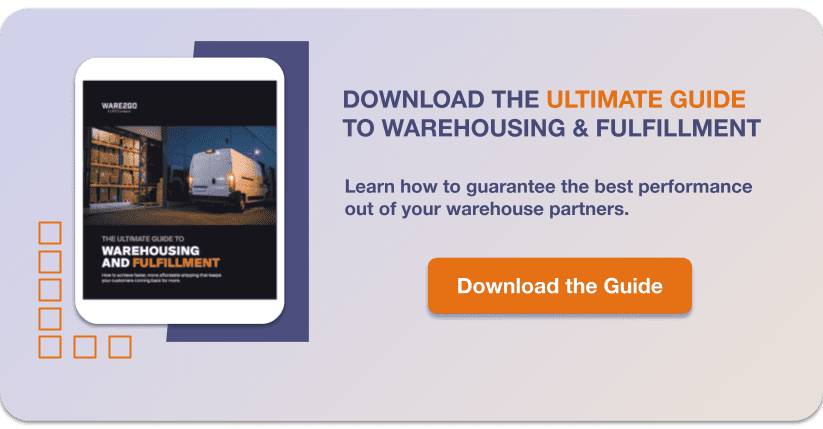Learn how automating processes and connecting your digital sales channels to a digital warehousing solution can help your business scale quickly and profitably.
What is Digital Warehousing?
Digital warehousing is the process of digitizing standard warehousing and fulfillment operations to keep up with the demands of modern ecommerce order volumes and consumer expectations. This digitization comes in the form of goods to human robotics, sophisticated warehouse management systems (WMS), shopping cart integrations, and more.
Digital warehousing has grown in response to the rapid evolution of digital sales channels. It has never been easier to launch and scale an online sales channel — from ecommerce shopping carts to third-party marketplaces, there are countless platforms to buy and sell online.
eCommerce platforms are flexible and can be turned on or off based on product availability, seasonal demand, or profitability. They can be integrated through a multichannel listing platform, so merchants can monitor and manage all of their digital sales channels through a single dashboard.
However, scaling a sales channel without having a flexible fulfillment solution that can meet the demands of ecommerce shipping expectations is a recipe for a frustrating customer experience. Ultimately, digital warehousing is the next step in the logistics industry that is enabling merchants to fully integrate their sales channels with their fulfillment operations. A flexible and scalable warehousing solution is really the only way for merchants to compete.

Digital Warehousing in Action
The first thought most people have when they think of digital warehousing is robotics and warehouse automation. Warehouse technology is an important part of the digital evolution of warehousing and fulfillment. It enables warehouse staff to move quickly to keep up with the exponential growth of small parcel and ecommerce order volume.
Warehouse technology like this conveyor and sortation system enable warehouse staff to sort and move a much higher volume of packages per day in order to keep up with their aggressive SLA’s.

The other key component to digital warehousing is in the software used to connect the warehouse to the merchants’ sales platform, otherwise known as the Warehouse Management System (WMS). The WMS platforms employed by many traditional 3PL’s certainly lack the flexibility and ease-of-use most merchants have grown accustomed to in their digital sales platforms.
New tech-enabled 3PL’s, 4PL’s, and on-demand warehousing providers place a greater priority on building robust and flexible WMS that can integrate seamlessly into a merchant’s current tech stack. A powerful WMS will also provide insights into real-time inventory levels, order statuses, and demand forecasting.
Schedule a demo of Ware2Go’s industry leading WMS platform
Benefits of Digital Warehousing
According to the Harvard Business Review, the digitization of the supply chain enables asset-light solutions that allow merchants to share warehousing space and even trucking capacity to lower costs and improve service levels. Other benefits of digital warehousing include:
- Improved efficiency: Processes like order management must be automated. Manually downloading an order report and uploading it to a warehouse or 3PL’s WMS eats up valuable time. When order uploads are automated and processed in real-time, there’s no risk of missing the order cut-off time for same-day fulfillment or having shipments delayed. A robust WMS will also automate the process of matching an order with the warehouse location closest to the end customer. This will help improve delivery times and save on shippig costs by eliminating long-zone shipments.
- Greater accuracy: Today’s ecommerce consumers have high expectations for order status updates and delivery tracking. 93% of consumers expect tracking information to be updated at least daily. Automated order updates and delivery tracking through a digital warehousing solution is the only scalable way to keep up with consumer expectations.
- Scalability: Relying on digital, rather than manual processes is the key to scaling quickly. When time-consuming processes like inventory management and order processing are automated, your fulfillment solution can move as quickly as your sales channels.
- Flexibility: Today’s merchants need to be able to respond quickly to new opportunities, whether that means new areas of geographic demand or shifting focus to an entirely new sales channel. When O2 Recovery saw an opportunity to pivot from their established retail channel to take advantage of new direct to consumer opportunities, their fulfillment partner was able to pivot with them because of their direct integration with O2’s Shopify store and the multi-modal transit flexibility within their WMS.
The Future of Digital Warehousing
As the logistics industry continues to evolve to keep pace with the new digital economy, the new frontier in digital warehousing will be machine learning and AI. The logistics industry has a wealth of data that can help merchants easily solve complex problems from demand forecasting to demand generation. When the logistics industry begins to leverage machine learning to analyze and aggregate WMS, TMS, and OMS data, they will be able to help merchants achieve three important things:
- Determine where their warehouses should be located according to geoproximity to their biggest customer bases, warehouse capacity, and required warehouse or transportation capabilities.
- Determine how much inventory they should carry and how it should be distributed, understand what skus they could add or remove from their product catalogue, and forecast when they should reorder inventory to strike the right balance of inventory carry costs and supplier bulk order discounts.
- Forecast demand based on historical sales and seasonal patterns. Demand forecasting enables merchants to align their marketing spend with available inventory to get the most out of seasonal peaks without experiencing stockouts or backorders that lead to frustrating customer experiences.
These three services are ultimately the key to unlocking demand generation. Many merchants try to solve the problem of demand from the top-down, but by implementing machine learning, digital warehousing can actually create demand.
Having inventory strategically located throughout a distributed warehouse network helps merchants of all sizes reach their best customers with 1 to 2-day shipping. Research shows that these faster delivery speeds actually create demand. In fact, research from Google revealed that merchants who advertised 1 to 2-day shipping promises at the top of the sales funnel saw increased overall conversion rates 9% higher than those who didn’t. By geo-targeting their best customers with increased service levels, merchants can raise their top-line revenue without significantly increasing their ad spend.
Additionally, an optimized fulfillment network lowers shipping and fulfillment costs by eliminating costly next-day air and long-zone shipments. This combined top-line and bottom-line revenue growth enabled by continued advancements in digital warehousing will add up to significant business impacts for SMB’s and high-growth merchants.
Looking for more insights the future of warehousing and fulfillment? Sign up for our monthly newsletter or follow us on LinkedIn.




